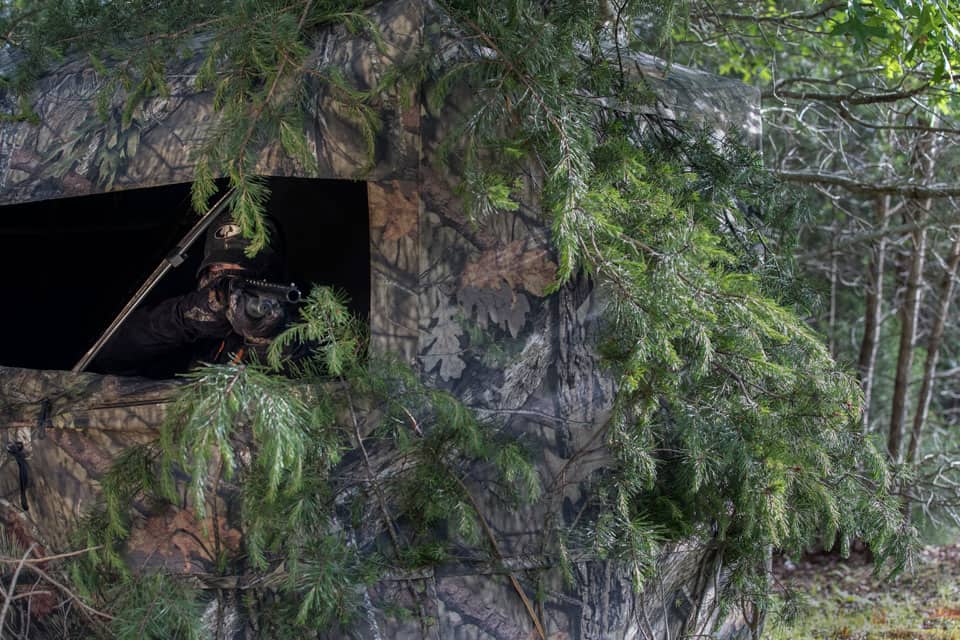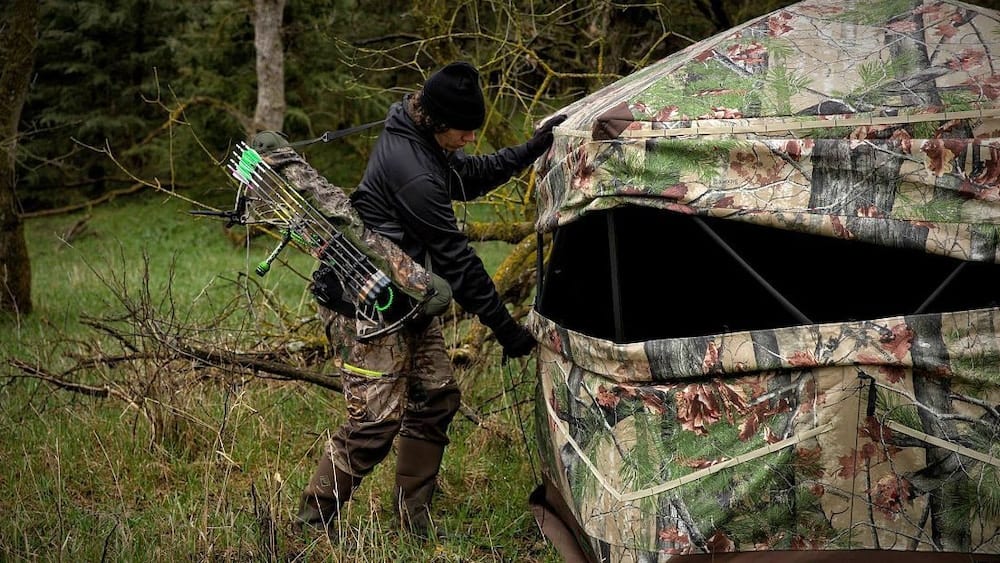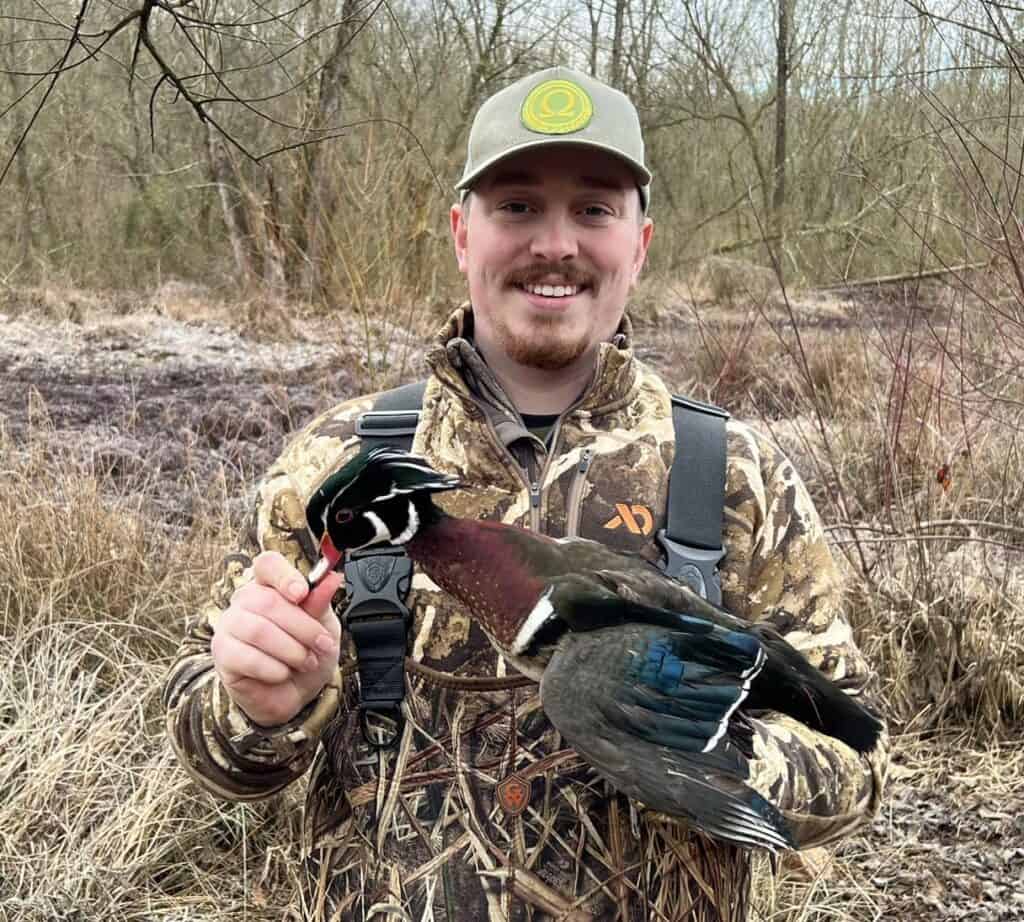For those of us used to hunting in elevated treestands, a ground blind provides a new perspective on hunting. They provide a whole host of new advantages. With the hunting and outdoor market making stronger innovations in ground blinds, they’re becoming a more and more effective means of concealment in the field. Although if they are so good at concealing you, do you need to wear camo?
When using a ground blind base your clothing on the weather and the color of your backdrop. In manufactured blinds, you should wear dark clothing and layer for the expected temperature. In non-weatherproof blinds, you should use weather-resistant garments.
Hunting on the ground is obviously nothing new. Our ancestors (heck even your grandpa) didn’t often hunt in a tree, much less from a saddle or aluminum climber. Being at the same elevation as your prey, be it deer, turkey, or any game animal, requires a different approach to your tactics and gear.
Let’s dive right into what you need to wear while hunting in a ground blind and some clothing considerations associated with your blind choice.

What Should I Wear in a Ground Blind?
While there’s no need to go out and replace your entire hunting wardrobe, what you wear plays an outsized role in concealment when you’re hunting from the ground. When we’re up in the air in a treestand, it’s good to blend in and have camo or dark colors, but deer and other game aren’t usually looking upward.
Animals are, however, going to study your ground blind over and over. Even when it’s familiar to them, they still check out their environment. Ground blinds fall under two main categories: pre-manufactured and homemade. You need to dress appropriately for both.
If you are wondering if you even need to wear camo at all, you should read my article called “Do You Need Camouflage for Hunting?” by clicking right here. It is inspired by the old timers who point out that their grandpa’s hunting in jeans and flannel, and then takes a deeper dive into the camo industry as a whole. It is worth a read!
What to Wear in a Pre-Manufactured Ground Blind
The first type of blind is one that you buy. They’re similar to tents, but with shooting ports or windows. They offer decent protection from the elements and a high degree of concealment for hunters. However, you’re still on the ground, at the same level as your quarry, so you need to be extra cautious about what you’re wearing.

Use Dark Colors
Inside a store-bought or commercial blind, it’s darker than it is outside no matter the light level. What does this mean for you on the inside? It means that your regular camo is OK, but a better option is black. If you’ve got a blind with open shooting ports, you absolutely do not want to move when there are deer around; your silhouette will be plain as day and send deer 180 degrees away from you in a heartbeat.
I’m talking about a black boggan (beanie for you yankees), a black jacket, a black sweatshirt (or whatever you wear under your jacket), and even a black mask or face paint.
Totally blacking out the clothing on your upper half is the best way to dress for hunting from a ground blind. Lighter colors or patterns might be visible from the outside and stand out against the darkened interior of the blind. Staying still is more important than the color of your clothes. This is no different than treestand hunting.
Clothing Material
As far as materials go, make sure you buy something that will be quiet. Some rain-repellent coats and pants are LOUD and scratchy when they rub together, so steer clear of those. I consider the best option to be fleece. Even though your pants won’t be visible in a ground blind, you’ll certainly shift and move your legs, so buy quiet pants as well.
You will also want to mind your scent control. I have an entire ebook about scent control and the best practices, but since you are here reading about ground blinds, you might be more interested in this article I recently wrote titled “Do Ground Blinds Help Scent Control?”. It tells you everything you need to know about scent control in a ground blind! Click right here to read it.
Did You Know I Had a Newsletter?! 📬
I do! I send out a weekly email that talks all about deer hunting and is a bit more personal than a regular article. If you sign up right now, I will even send you the first chapter of my Ebook “The Hunters Guide to Scent Control” for free! What is there to lose? 🙂
What to Wear in a Natural/Homemade Ground Blind
The second type of ground blind is one that you make. They’re a lot more affordable (free even!) but require a lot more sweat equity to put together. These are usually made with natural and native forage sourced near where you want the blind to be (you don’t want to drag limbs all over the place, do you?). Ideally, you’ll have some T-posts driven into the ground for an outline of sorts, then built up branches and limbs around the posts to make the walls of the blind.
The best-case scenario is one where you have shooting ports, but this often involves making an extremely elaborate blind that’s not feasible for most. So most often the sides or “walls” of a ground blind come up to your midsection while seated. This keeps your bottom half almost perfectly concealed but your top half exposed and out in the open. In this scenario, discipline and proper attire are paramount.
Color and Pattern Choices
Unlike a commercial or store-bought ground blind, black isn’t the best option for a natural blind unless you have built a full containment blind with a blacked-out interior. Even if you’ve created your blind beneath a thick, shady tree (which isn’t a bad idea), you’re going to want to match the natural vegetation surrounding you.
Your choice of camo is up to you, but you generally don’t want to contrast with your surroundings. Dark surroundings warrant dark camo. Bright surroundings means you should be picking lighter patterns. This includes a face mask, which you’ve probably already got if you’re a turkey hunter.
Full camo head to toe is the only way to go in a natural ground blind. You might even splurge for a leafy jacket that really breaks up your outline. I have used a thin one like this one on Amazon to hunt just about everywhere. Plus, it is good to wear during the early season when it is blazing hot here in north Georgia since it is more like a net than a shirt.
As far as the rest of your clothing is concerned, you want to wear something that is going to keep you warm, and isn’t noisy when it moves. Of course, it should also be camouflage. I consider fleece again as the best bet for quietness. I wore a First Lite fleece pullover all last season, and it was awesome. Fleece is time-tested to be warm and silent, and you can still find fleece pants and coats in today’s market that’s saturated with high-tech materials.

If I experience rain regularly in the location I am hunting, I will pick a weather-resistant shell to layer over my garment of choice. Decent quality weather-resistant garments will make noise, so I only use them when needed. Generally, when it is raining there is a small amount of white noise that will cover the sound of your movement. When the weather improves the shell comes off and is in my backpack.
Keeping Your Natural Ground Blind Going
Keep in mind that as the material your blind is composed of dies, it’s going to thin out, lose shape, and change color. Keep it refreshed (as long as you can) by filling in gaps and refining its shape each time you go. You’ll find that natural ground blinds reach perfection just about the time the season is over.
With your head, neck, and part of your torso exposed, movement discipline is important. Nothing is more critical than remaining still. You’ll never know how many critters your spook if you’re fidgeting and looking all over instead of sitting quietly, relying on your hearing and peripheral vision. Thankfully, the blind covers up a lot of that, but it isn’t a free pass to do jumping jacks, your movement should be minimal.
The Bottom Line
For the TL;DR crowd, when you’re hunting from a ground blind, what you wear matters more on the ground than when you’re in a treestand. If you’re hunting from a natural blind you made, wear appropriate camo patterns from head to toe, even covering your face. Mind your scent really well and for the love of all that’s holy, SIT STILL.
If you’re in a pop-up blind, wear all black. Cover your face with a mask or paint if it’s hot out to prevent shining like a SOS mirror. Dark gloves will keep you from showing your movements when your hands are above your blind’s walls.
No matter which kind of blind you’re in, wearing fleece or a silent fabric gives you the advantage; you’re right there eye to eye with the deer where their senses are sharpest, so give yourself a better chance and black yourself out.
Sister Post | What Should You Have In Your Ground Blind?
A sister post is another post that I have written that follows along with the same topic as the one you just read. After reading this article, you will probably like this next one even more! Here is a little teaser…
Ground blinds are easy to use, but you do need to consider bringing a few items that you typically wouldn’t need in a treestand…Keep Reading
Gear for Staying Cool or Warm
One of the great things about hunting from ground blinds during cool temperatures is that they can hold in heat. On the flip side, during hot weather blinds can roast you…Keep Reading
All The Other Junk We Take Hunting
If you’re deer hunting you will likely have rattling antlers, grunt tubes, a headlamp, and plenty of other gear that you will want quick access to…Keep Reading
Thank you for reading my article! I hope you enjoyed it, and if you have any questions or feedback, please send me an email at [email protected]. If you want to learn more about me or Omega Outdoors, visit my About Page. Otherwise, I hope you have a great day, and check out some of my other articles while you’re here!

